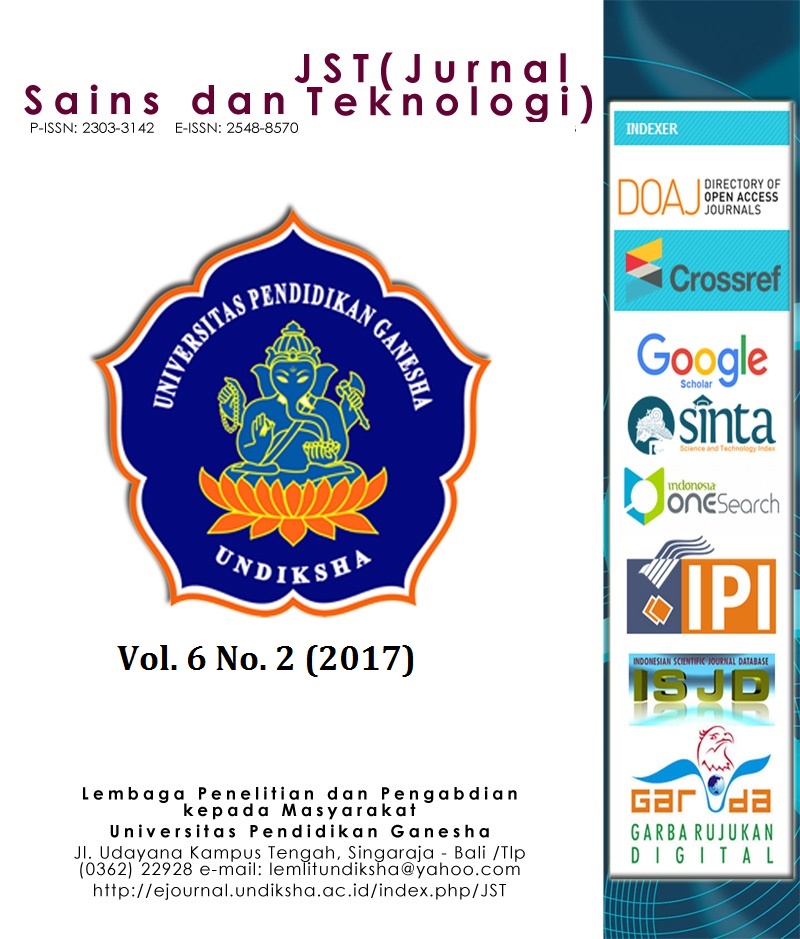IDENTIFIKASI RANGKAIAN GEMPA BUMI PENDAHULUAN (FORESHOCKS) DENGAN PENDEKATAN KORELASI SILANG SINYAL SEISMIK TEMPLATE (STUDI KASUS RANGKAIAN GEMPA BUMI KARO 2017)
DOI:
https://doi.org/10.23887/jstundiksha.v6i2.11800Keywords:
foreshock, gempa, BMKG, matched filterAbstract
Penelitian ini berhasil membuktikan bahwa pendekatan korelasi silang sinyal seismik dapat digunakan untuk mendeteksi kejadian seismik menggunakan waveform dari jaringan BMKG (Badan Meteorologi Klimatologi dan Geofisika). Pendeteksian ini dilakukan untuk melengkapi kejadian gempa bumi yang belum tercatat pada katalog reguler BMKG karena berbagai keterbatasan. Adanya rangkaian kejadian gempa pendahuluan (foreshock sequence) sebelum kejadian gempa Karo M 5,6 tanggal 16 Januari 2017 berhasil teridentifikasi. Tujuan dari penelitian ini adalah melakukan identifikasi kejadian gempa bumi pendahuluan (foreshocks) dengan memanfaatkan data sinyal template gempa bumi M 3,9 yang sebelumnya dianggap sebagai satu-satunya foreshock dalam rangkaian kejadian ini. Penelitian ini berhasil mendeteksi 12 kejadian gempa pendahuluan (foreshocks) setelah diterapkan metode deteksi berbasis korelasi silang. Foreshock mulai terdeteksi pada tanggal 14 Januari 2017 atau dua hari sebelum gempa utama. Magnitudo gempa pendahuluan semakin meningkat secara sistematis sampai kejadian gempa pendahuluan terbesar. Penelitian ini berimplikasi pada manfaat penerapan metode deteksi berbasis waveform untuk mendukung pemahaman fisis sumber gempa dan prediksi gempa bumi di Indonesia.
References
Brodsky, E. E., 2011, The spatial density of foreshocks, Geophys. Res. Lett., 38, L10305, doi:10.1029/2011GL047253.
Chen, X., dan P. M. Shearer, 2015, Analysis of foreshock sequences in California and implications for earthquake triggering, Pure Appl. Geophys., 173, 1, 133-152, doi: 10.1007/s00024-015-1103-0.
Gibbons, S. J., dan F. Ringdal, 2006, The detection of low magnitude seismic events using array-based waveform correlation, Geophys. J. Int., 165: 149–166. doi:10.1111/j.1365-246X.2006.02865.x.
Huang, H., L. Meng, M. Plasencia, Y. Wang, L. Wang, M. Xu, 2016, Matched-filter detection of the missing pre-mainshock events and aftershocks in the 2015 Gorkha, Nepal earthquake sequence, Tectonophysics, in press, corrected proof, doi: 10.1016/j.tecto.2016.08.018.
Hurukawa, N., 1998, The 1995 off-Etorofu earthquake: Joint relocation of foreshocks, the mainshock, and aftershocks and implications for the earthquake nucleation process, Bull. Seismol. Soc. Am., 88, 5, 1112-1126.
Kato, A., dan S. Nakagawa, 2014, Multiple slow-slip events during a foreshock sequence of the 2014 Iquique, Chile Mw 8.1 earthquake, Geophys. Res. Lett., 41, 5420–5427, doi:10.1002/2014GL061138.
Kato, A., J. Fukuda, dan K. Obara, 2013, Response of seismicity to static and dynamic stress changes induced by the 2011 M9.0 Tohoku-Oki earthquake, Geophys. Res. Lett., 40, 3572–3578, doi:10.1002/grl.50699.
Kato, A., J. Fukuda, S. Nakagawa, dan K. Obara, 2016, Foreshock migration preceding the 2016 Mw 7.0 Kumamoto earthquake, Japan, Geophys. Res. Lett., 43, doi:10.1002/2016GL070079.
Kato, A., K. Obara, T. Igarashi, H. Tsuruoka, S. Nakagawa, dan N. Hirata, 2012, Propagation of slow slip leading up to the 2011 Mw 9.0 Tohoku-Oki earthquake, Science, 335, 6069, 705-708, doi: 10.1126/science.1215141.
McCaffrey, R., 2009, The Tectonic framework of the Sumatran Subduction Zone, Annu. Rev. Earth Planet. Sci., 37, 345–366, doi:10.1146/annurev.earth.031208.100212.
Meng, X., X. Yu, Z. Peng, dan B. Hong, 2012, Detecting earthquakes around Salton Sea following the 2010 Mw 7. 2 El Mayor-Cucapah earthquake using GPU parallel computing, Procedia Comp. Sci. 9, 937–946, doi:10.1016/j.procs.2012.04.100.
Meng, X., Z. Peng, dan J. L. Hardebeck, 2013, Seismicity around Parkfield correlates with static shear stress changes following the 2003 Mw 6.5 San Simeon earthquake, J. Geophys. Res. Solid Earth, 118, 3576–3591, doi:10.1002/jgrb.50271.
Mogi, K., 1963, Some discussions on aftershocks, foreshocks and earthquake swarms – the fracture of a semi-infinite body caused by an inner stress origin and its relation to the earthquake phenomena, Bull. Earthq. Res. Inst. Univ. Tokyo, 41, 615–658.
Peng, Z., dan P. Zhao, 2009, Migration of early aftershocks following the 2004 Parkfield earthquake, Nature Geoscience, 2, 877–881, doi:10.1038/ngeo697.
Shelly, D. R., G. C. Beroza, dan S. Ide, 2007, Non-volcanic tremor and low-frequency earthquake swarms, Nature, 446, 305-307, doi:10.1038/nature05666.
Sugan, M., A. Kato, H. Miyake, S. Nakagawa, dan A. Vuan, 2014, The preparatory phase of the 2009 Mw 6.3 L’Aquila earthquake by improving the detection capability of low-magnitude foreshocks, Geophys. Res. Lett., 41, 6137–6144, doi:10.1002/2014GL061199.
Wang, J. -H., 2016, A mechanism causing b‐value anomalies prior to a mainshock, Bull. Seismol. Soc. Am., 106, 4, 1663-1671, doi: 10.1785/0120150335.
Downloads
Published
How to Cite
Issue
Section
License
Authors who publish with the Jurnal Sains dan Teknologi (JST) agree to the following terms:
- Authors retain copyright and grant the journal the right of first publication with the work simultaneously licensed under a Creative Commons Attribution License (CC BY-SA 4.0) that allows others to share the work with an acknowledgment of the work's authorship and initial publication in this journal.
- Authors are able to enter into separate, additional contractual arrangements for the non-exclusive distribution of the journal's published version of the work (e.g., post it to an institutional repository or publish it in a book), with an acknowledgment of its initial publication in this journal.
- Authors are permitted and encouraged to post their work online (e.g., in institutional repositories or on their website) prior to and during the submission process, as it can lead to productive exchanges, as well as earlier and greater citation of published work. (See The Effect of Open Access)
















